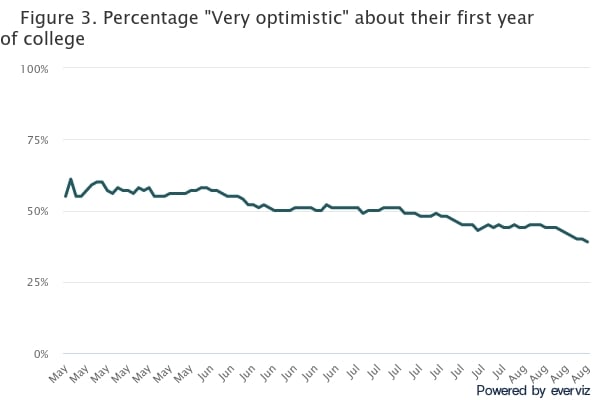You have /5 articles left.
Sign up for a free account or log in.

Matthew Hatcher/Getty Images
As incoming college students start their first weeks of postsecondary education, many are optimistic about a new beginning, but they are also struggling with mental health and academic challenges created by the pandemic.
The annual Beginning College Survey of Student Engagement found that 53 percent of first-year students reported a substantial increase in mental and emotional exhaustion. Of those, nearly 70 percent indicated "high expectations of academic difficulty," compared to 42 percent of their peers who did not experience greater exhaustion. Additionally, 30 percent of students surveyed reported increased depression, 27 percent said they experienced greater loneliness and 20 percent felt more hopeless.

"The combination of mental and emotional exhaustion and expected academic difficulty strongly suggests an imperative to implement widespread and early check-ins by faculty, academic advisors, and student life staff to offer the support and -- if necessary -- intervention to help students’ first college year be successful," the survey said.
Between May and early August of this year, more than 35,000 students took the BCSSE survey, which is administered by Indiana University’s Center for Postsecondary Research. The survey will remain open until mid-September, ultimately collecting data from an estimated 50,000 entering first-year students.
The results come as institutions expand their mental health services for the upcoming semester. Throughout the pandemic, college students have had difficulty accessing mental health care and have experienced higher rates of depression because of COVID-19.
Erica Riba, director of higher education and student engagement at the Jed Foundation, a nonprofit that protects emotional health and works to prevent suicide among teenagers and young adults, said the results of the BCSSE aren’t surprising. “COVID has been pretty multidimensional for many folks,” she said. “And there has been collective trauma across the board on student mental health … There’s been great loss throughout this last year and a half.”
The Jed Foundation created guidance earlier this month to address campus mental health and well-being for the fall semester. Riba said it’s up to institutions to create the right environment for students to succeed during the pandemic. “What’s key is to remind everyone that we’re really not out of the woods yet with COVID-19,” she said. “We have to come at this from a health and safety perspective, and that includes well-being and mental health. We need to really design when we return to campus a culture of caring, compassion and belongingness.”
The survey also found that although student optimism is dropping, it remains strong. The majority of incoming students expressed enthusiasm about their first year, and most said that COVID-19 didn't interfere much with their college plans.

The results also highlight the different learning environments the students had during their senior year of high school, with the majority of students experiencing some kind of online learning. About 60 percent had hybrid instruction during their senior year, while 26 percent took classes entirely online and 14 percent had classes entirely in person.
Going forward, more than half of students said they “strongly” preferred in-person instruction in college, with those who finished high school online only half as likely as those who didn't to favor in-person teaching.
Results for online and in-person learning varied by racial and ethnic identity, with about half of Black or African American (47 percent), Hispanic or Latina/o (51 percent), and Asian (49 percent) students experiencing entirely online instruction.

The differences between the overall result and the findings among minority groups should be examined, the survey said, in order to see how resources are provided for diverse groups of students.
Riba said that a return to in-person learning needs to account for students in minority groups and create campuses where those students feel safe. “What higher education needs to be aware of is consideration of how resources are shared among racial minority groups, making sure that there are spaces for students to come together,” she said. “We’re really recognizing the need to increase our resources, and make sure that those who come from disadvantaged backgrounds are really recognized and heard.”




